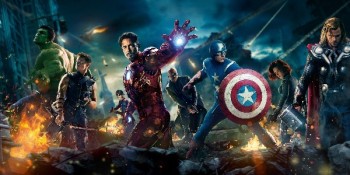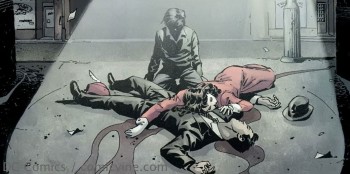Every few years, a movie transforms the way Hollywood does business. The Birth of a Nation, Star Wars, and others changed the game through their financial and cinematic successes. Marvel’s The Avengers, released in 2012, changed the game again.
By taking their time and releasing five distinct movies before The Avengers, Marvel laid down a strong foundation on which to build. Audiences were intrigued by Iron Man, Thor, The Hulk, and Captain America, but they were much more intrigued by what would happen when these cinematic characters met for the first time. When The Avengers was finally released, Marvel succeeded not only financially, but in creating something entirely new to cinema: the megafranchise.
The Avengers has grossed over $1.5 billion internationally and has had residual effects on other Marvel Studios releases. The Winter Soldier has grossed almost twice what its predecessor, Captain America, has, and Thor’s box office receipts increased for its second installment by around 50 percent as well. The result has been attempts by other studios, specifically those with the rights to superhero properties, to duplicate Marvel’s success. Some have done well trying to adapt to this model, but others are risking the destruction of their franchises by not understanding what made The Avengers so successful.
The idea of a megafranchise is that several stories and characters that are commercially viable in their own right work together under the same fictional umbrella in such a way that all component properties end up being more successful, with the eventual crossover making even more money. The cinematic megafranchise has roots in the superhero comic book.
Since All-Star Comics #3, released in 1940 by DC Comics, comic books have been using crossovers to build interest in new characters and to increase profits in existing titles. All-Star #3 saw the formation of the Justice Society of America, the first super-powered team to star characters from several different series, including the original versions of The Flash, Green Lantern, Sandman, and more.
DC may have been the first to use the team-up tactic in comics, but Marvel made the crossover its modus operandi. When Stan Lee first introduced his brand of Marvel heroes, he revolutionized the industry by making his heroes flawed and fallible. Flawed heroes are susceptible to human errors, including misunderstanding the motivations of other heroes. That makes the possibilities of crossovers endless, with heroes like Daredevil mistaking the antics of Spider-Man, leading to a fight in New York City.
Lee saw this potential and made sure to place all of his heroes in a single, interconnected fictional world. Creating a Marvel Universe where crossovers were expected helped to make Marvel the industry leader. Crossover stories would allow fans to see who would win in a fight between their favorite heroes, but also helped to raise the value of lesser-known characters. This tactic was used well in Avengers comics from the beginning.
The Avengers came together in 1963 with an all-star lineup of Iron Man, Thor, Hulk, Ant-Man, and Wasp. Three issues later, they were joined by Marvel heroes’ patriarch, Captain America. It wasn’t long, however, before the creative team at Marvel began using the Avengers to promote lesser-known heroes. In only its 13th issue, the Avengers lost the entire original lineup and reformed with Captain America leading a “cooky quartet” including Hawkeye, Scarlet Witch, and Quicksilver. All three of Cap’s cohorts were originally villains and were using the superhero team as a way to achieve redemption — and to gain greater notoriety among comic book fans.
With the increasing popularity of comic book movies, it was inevitable that Hollywood would adapt Lee’s storytelling style, especially when one of the studios making superhero movies actually was Marvel. Marvel had sold away the rights to its biggest properties a long time ago, losing X-Men, Spider-Man, Fantastic Four, and more. So, when Marvel decided to create its own film studio, the options for franchises were limited.
Marvel Studios took a gamble on a second-tier hero known as Iron Man, who was created by Lee as a sort of challenge to himself: he wanted to create a hero who would be very unlikable to his anti-establishment audience and force them to like him. And thus, Tony Stark, the billionaire, playboy, industrialist, was born. In the movies, Marvel relied on Robert Downey Jr. to deliver both the audience and a show-stealing performance.
By showing the world what could be done with its remaining superhero properties, Marvel Studios built in an audience for additional films. But Iron Man did so much more. The post-credits appearance of Samuel L. Jackson as Nick Fury told fans there was much more to see — that the world of Iron Man was vastly larger than just Tony Stark.
Every succeeding movie built on the groundwork of Iron Man by adding more to the mythos and getting fans excited for the next new entry. People who would not normally be fans of Norse mythology were interested in seeing Thor thanks to the allusions to Mjolnir in Iron Man 2. People who thought Captain America would be a hokey movie still bought tickets because they knew it was building to something larger. By the time The Avengers was released, it was a foregone conclusion that it would be a true blockbuster.
Studios that had already been making superhero movies for years took notice but found themselves in a difficult situation. 20th Century Fox had been producing X-Men movies for a long time and tried to use the team movies to spin off into solo titles, an inverse of what Marvel had been doing. Unfortunately, to this day, Fox has created only one independent franchise, in Wolverine.
With the success of The Avengers, Fox chose to follow the Marvel model by creating a movie loaded with heroes. The result, X-Men: Days of Future Past, was an incredible movie that deserves its comparisons to The Avengers as among the best superhero movies ever made. But its success is nowhere near the level of The Avengers. Why? Because many of the X-Men characters have been seen together already, and there has been no franchise dedicated entirely to building stories for Magneto, Mystique, Storm, or any of the other heroes featured in DoFP.
Sony Pictures’ answer to Marvel has been to use the Spider-Man villains in their own spinoff movies since the Spider-Man franchise is limited to only one major hero. Rumors abound about a Venom movie, which fans hope will lead to the first screen adaptation of Carnage, and Sony has practically confirmed it will produce a movie based on the Sinister Six, a team of six supervillains.
In its attempts to build a megafranchise, however, Sony has made some mistakes. By cramming several villains into The Amazing Spider-Man 2, none of the new characters were able to flesh out their motivations and become more compelling to movie audiences. Though I believe Amazing 2 actually was pretty amazing, other fans weren’t so happy, thinking Sony displayed for everyone the pitfalls of getting too overzealous when attempting to build a megafranchise.
The worst offender of trying to duplicate Marvel’s success has been Warner Brothers. Time Warner owns DC Comics and has had the rights to make movies based on some of the most popular heroes in the world for a long time. Yet somehow, Warner Brothers has mostly only been able to spit out movies based on their two major icons, Batman and Superman, while completely ignoring their third, Wonder Woman, and doing a poor job with Green Lantern.
In a terribly misguided attempt to catch up to Marvel, Warner Brothers has been working on a sequel to Man of Steel, which has slowly evolved into a prequel to a future Justice League film. In trying to build a megafranchise, Warner Brothers has forgotten that it requires the strength of several independent franchises first. Warner Brothers is looking to skip all of that, hoping that the idea of a Batman versus Superman movie will be enough to sell tickets. And it will be.
Warner Brothers has been considering this crossover movie for decades — and for good reason. There are no two characters more iconic than the Dark Knight and the Man of Steel. But in their impatience, Warner has added Wonder Woman, who should have had her own movie years ago, as a third wheel, as well as Cyborg. Also, no movies starring Flash, Aquaman, Martian Manhunter, Green Arrow, or any other major DC hero have been announced. What Warner Brothers did announce, however, is an official Justice League movie, to be directed by Zack Snyder.
But if a movie is coming out in two years that features DC’s top three heroes together for the first time, what reason do casual superhero fans have of going to see the Justice League movie? Are unestablished Green Lantern and Flash characters going to be interesting enough to sell tickets? It’s doubtful.
Marvel made an effort to make sure we fell in love with their characters who would not normally sell tickets on their own by promising us a greater movie experience in the future. Once we had that experience, we fell in love with the characters, even leaving The Avengers asking for a Black Widow movie, which would have been unheard of a decade ago. The success of the megafranchise has created greater success for its constituent franchises, with Iron Man, Thor, and Captain America all seeing increased revenue for their newest cinematic outings. These successes have even allowed Marvel to take new risks, with D-level properties Guardians of the Galaxy and Ant-Man coming to theaters in the next year.
Marvel has proved that it has a winning formula, but it is one that takes time and patience. Fox is beginning to work toward creating a stronger megafranchise in the X-Men by producing more solo movies for characters outside of Wolverine, but Fox’s lack of faith in strong mutant characters, many of whom are women, is holding the studio back. And Sony has shown the risk of relying too heavily on creating a megafranchise, to the detriment of the existing franchises. But Warner Brothers, which has the strongest chance of creating a tremendous cinematic universe, is missing out on the opportunity to create several strong franchises in favor of taking a quicker path to a megafranchise — one that is unlikely to be able to match the success of The Avengers.
Will Justice League, Sinister Six, and future X-Men team-up movies be successful? As a fan of superhero movies, I certainly hope so. But I am willing to wait for them to be set up correctly. As fans, we would much rather see strong movies based on Wonder Woman, the Flash, Green Lantern, and even Cyborg before being thrust into the world of the Justice League. Unfortunately, the promise of Avengers-level profits have clouded the minds of Hollywood producers. Hopefully, they will start to see things long-term, before a massive flop kills the momentum of the superhero genre.

